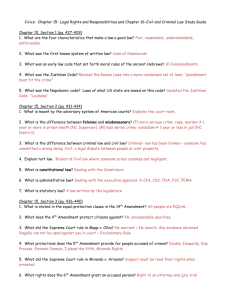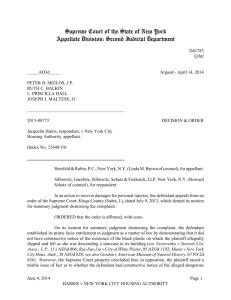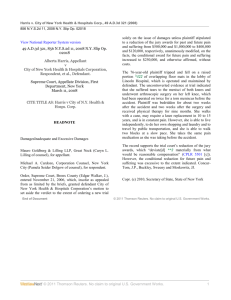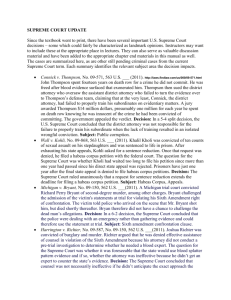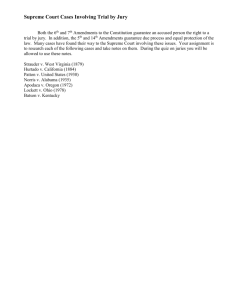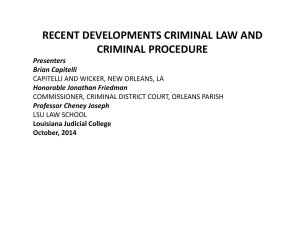This resource provides you with brief synopses of the court cases
advertisement
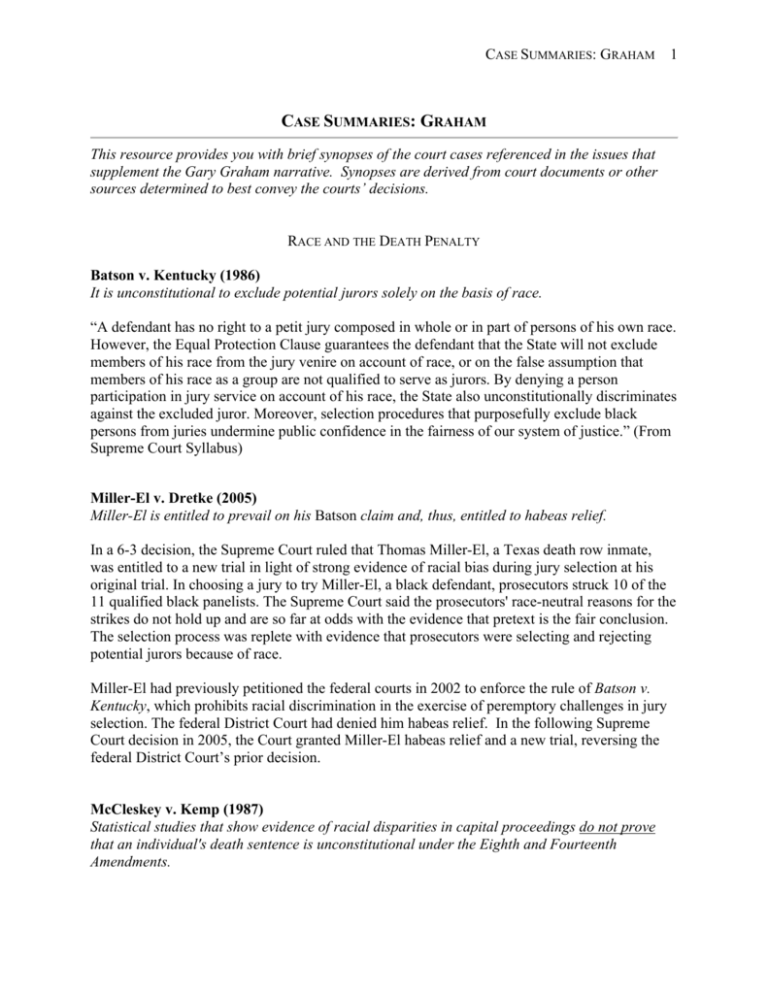
CASE SUMMARIES: GRAHAM 1 CASE SUMMARIES: GRAHAM This resource provides you with brief synopses of the court cases referenced in the issues that supplement the Gary Graham narrative. Synopses are derived from court documents or other sources determined to best convey the courts’ decisions. RACE AND THE DEATH PENALTY Batson v. Kentucky (1986) It is unconstitutional to exclude potential jurors solely on the basis of race. “A defendant has no right to a petit jury composed in whole or in part of persons of his own race. However, the Equal Protection Clause guarantees the defendant that the State will not exclude members of his race from the jury venire on account of race, or on the false assumption that members of his race as a group are not qualified to serve as jurors. By denying a person participation in jury service on account of his race, the State also unconstitutionally discriminates against the excluded juror. Moreover, selection procedures that purposefully exclude black persons from juries undermine public confidence in the fairness of our system of justice.” (From Supreme Court Syllabus) Miller-El v. Dretke (2005) Miller-El is entitled to prevail on his Batson claim and, thus, entitled to habeas relief. In a 6-3 decision, the Supreme Court ruled that Thomas Miller-El, a Texas death row inmate, was entitled to a new trial in light of strong evidence of racial bias during jury selection at his original trial. In choosing a jury to try Miller-El, a black defendant, prosecutors struck 10 of the 11 qualified black panelists. The Supreme Court said the prosecutors' race-neutral reasons for the strikes do not hold up and are so far at odds with the evidence that pretext is the fair conclusion. The selection process was replete with evidence that prosecutors were selecting and rejecting potential jurors because of race. Miller-El had previously petitioned the federal courts in 2002 to enforce the rule of Batson v. Kentucky, which prohibits racial discrimination in the exercise of peremptory challenges in jury selection. The federal District Court had denied him habeas relief. In the following Supreme Court decision in 2005, the Court granted Miller-El habeas relief and a new trial, reversing the federal District Court’s prior decision. McCleskey v. Kemp (1987) Statistical studies that show evidence of racial disparities in capital proceedings do not prove that an individual's death sentence is unconstitutional under the Eighth and Fourteenth Amendments. CASE SUMMARIES: GRAHAM 2 The Baldus study (a statistical study on racial disparities in the application of the death penalty) does not demonstrate that the Georgia capital sentencing system violates the Eighth Amendment. McCleskey (petitioner) failed to establish that the sentence in his case is disproportionate to the sentences in other murder cases. Since petitioner's sentence was imposed under Georgia sentencing procedures that focus discretion “on the particularized nature of the crime and the particularized characteristics of the individual defendant,” it may be presumed that his death sentence was not “wantonly and freakishly” imposed, and thus that the sentence is not disproportionate within any recognized meaning under the Eighth Amendment. The Baldus study does not establish that the administration of the Georgia capital punishment system violates the Fourteenth Amendment. Although the Court has accepted statistics as proof of intent to discriminate in the context of a State's jury selection, petitioner failed to prove that the decision-makers in his case acted with discriminatory purpose. CASE SUMMARIES: GRAHAM 3 DEFENSE REPRESENTATION IN CAPITAL CASES Powell v. Alabama (1932) The due process clause of the Fourteenth Amendment requires that if the accused is unable to retain his own counsel or make an adequate defense, the court must assign counsel to represent him. Gideon v. Wainwright (1963) “Charged in a Florida State Court with a non-capital felony, petitioner appeared without funds and without counsel and asked the Court to appoint counsel for him, but this was denied on the ground that the state law permitted appointment of counsel for indigent defendants in capital cases only. Petitioner conducted his own defense about as well as could be expected of a layman, but he was convicted and sentenced to imprisonment. Subsequently, he applied to the State Supreme Court for a writ of habeas corpus, on the ground that his conviction violated his rights under the Federal Constitution. The State Supreme Court denied all relief. Held: The right of an indigent defendant in a criminal trial to have the assistance of counsel is a fundamental right essential to a fair trial, and petitioner's trial and conviction without the assistance of counsel violated the Fourteenth Amendment.” (From Supreme Court Syllabus) Douglas v. California (1963) Two defendants were tried jointly for non-capital crimes, convicted and sentenced to prison. They petitioned the appellate court for counsel for their appeals and were denied. Their appeals were heard without any defense counsel and the defendants’ sentences were affirmed. The Supreme Court held that if a defendant’s state criminal case appeal is decided without “benefit of counsel,” the Fourteenth Amendment has been violated. Strickland v. Washington (1984) The Sixth Amendment’s guarantee of the right to counsel includes the right to effective counsel at both trial and appeal stages. If a convicted defendant claims that his or her counsel was ineffective, the defendant must show first that “counsel's performance was deficient and, second, that the deficient performance prejudiced the defense so as to deprive the defendant of a fair trial.” If the defendant succeeds on both counts, there may be a reversal of the conviction or the sentence. CASE SUMMARIES: GRAHAM 4 Murray v. Giarratano (1989) In 1963, the U.S. Supreme Court held in Gideon v. Wainwright that criminal defendants are entitled to lawyers for their trials, and this right was extended to their first round of appeals. In 1989 in Murray v. Giarratano, the Court held that state habeas petitioners were not entitled to representation provided by the state. The decision is widely understood to require only that inmates have access to adequate prison law libraries. Smith v. Robbins (2000) “An attorney appointed to represent an indigent defendant on appeal may conclude that an appeal would be frivolous and request that the appellate court allow him to withdraw or that the court dispose of the case without the filing of merits briefs.” (From Supreme Court Syllabus) Williams v. Taylor (2000) In state court proceedings, a “fail[ure] to develop” a claim’s factual basis can be established due to a “lack of diligence, or some greater fault, attributable to the prisoner or his counsel.” (From Supreme Court Syllabus) Wiggins v. Smith (2003) By not investigating information about the defendant’s dysfunctional background, the defense attorney was unable to make a proper decision about offering such evidence in mitigation and hence violated the defendant’s Sixth Amendment right to effective assistance of counsel. Rompilla v. Beard (2005) “Even when a capital defendant and his family members have suggested that no mitigating evidence is available, his lawyer is bound to make reasonable efforts to obtain and review material that counsel knows the prosecution will probably rely on as evidence of aggravation at the trial’s sentencing phase.” (From Supreme Court Syllabus) Barbour v. Haley (2006) (U.S. District Court for the Middle District of Alabama, Northern Division) “The plaintiffs reiterate in their motion for final judgment their claim that the Sixth Amendment requires ‘the State of Alabama to provide counsel to indigent condemned inmates prior to the filing of their post-conviction petition.’ The plaintiff’s Sixth Amendment claims lack merit, and they are not entitled to relief…. CASE SUMMARIES: GRAHAM 5 “In sum, the court concludes that as a matter of law the right of meaningful access does not require the State of Alabama to provide counsel to death row prisoners for the purpose of investigating and the filing of post-conviction proceedings. The claim that the State of Alabama is constitutionally required to appoint counsel to death row inmates for the investigation, preparation and prosecution of their state post-conviction challenges to their convictions must be denied with prejudice…. “The plaintiff class further contends that if the appointment of counsel is not constitutionally required, the state must provide some form of legal assistance. The plaintiff class is not entitled to relief on this claim.” (From the District Court’s Memorandum Opinion) CASE SUMMARIES: GRAHAM 6 INNOCENCE AND THE DEATH PENALTY Herrera v. Collins (1993) A defendant's claim of actual innocence does not entitle him to federal habeas relief. The Court held that the defendant's claim of actual innocence based on newly discovered evidence, absent an independent constitutional violation, was not a ground for federal habeas corpus relief. The function of federal habeas courts is not to correct errors of fact, but to ensure that individuals are not imprisoned in violation of the Constitution. A proper remedy for a claim of actual innocence based on new evidence that is discovered too late to file a new trial motion could be executive clemency. Schlup v. Delo (1995) The Court ruled that a convicted murderer who had other constitutional claims in addition to an innocence claim could get a new hearing if he could show that his new evidence makes it probable that "no reasonable juror would have found him guilty beyond a reasonable doubt." (From Supreme Court Syllabus) Manson v. Braithwaite (1977) The Due Process Clause of the Fourteenth Amendment does not automatically require the exclusion of the identification evidence in this case. “Reliability is the linchpin in determining the admissibility of identification testimony for confrontations occurring both prior to and after Stovall v. Denno, wherein it was held that the determination depends on the ‘totality of the circumstances.’ The factors to be weighed against the corrupting effect of the suggestive procedure in assessing reliability are set out in Neil v. Biggers, and include the witness' opportunity to view the criminal at the time of the crime, the witness' degree of attention, the accuracy of his prior description of the criminal, the level of certainty demonstrated at the confrontation, and the time between the crime and the confrontation.” (From Supreme Court Syllabus) Neil v. Biggers (1972) The defendant was convicted of rape on evidence that consisted in part of testimony concerning the victim's visual and voice identification of the defendant at a station-house lineup that occurred seven months after the rape. The Court's affirmation of the defendant’s state court conviction does not bar further federal relief by habeas corpus. Likewise, though the identification processes in the police station may have been suggestive, under the totality of the circumstances the victim's identification of respondent was reliable and was properly allowed to go to the jury. CASE SUMMARIES: GRAHAM 7 LEGAL REMEDIES AVAILABLE TO DEATH SENTENCED INDIVIDUALS Graham v. Collins (1993) After his conviction, Gary Graham appealed to the Supreme Court, alleging that his sentencing jury did not hear “mitigating evidence of his youth, unstable family background, and positive character traits.” The Supreme Court had to determine whether “reasonable jurists hearing [Graham’s] claim at the time of his conviction became final ‘would have felt compelled by existing precedent’ to rule in his favor. Applying this standard, the Court denied relief.” (From Capital Punishment and the Judicial Process by Coyne, as well as the Supreme Court Syllabus). Murray v. Giarratano (1989) In 1963, the U.S. Supreme Court held in Gideon v. Wainwright that criminal defendants are entitled to lawyers for their trials, and this right was extended to their first round of appeals. In 1989 in Murray v. Giarratano, the Court held that state habeas petitioners were not entitled to representation provided by the state. The decision is widely understood to require only that inmates have access to adequate prison law libraries. CASE SUMMARIES: GRAHAM 8 THE DEATH PENALTY FOR JUVENILES Graham v. Collins (1993) After his conviction, Gary Graham appealed to the Supreme Court, alleging that his sentencing jury did not hear “mitigating evidence of his youth, unstable family background, and positive character traits.” The Supreme Court had to determine whether “reasonable jurists hearing [Graham’s] claim at the time of his conviction became final ‘would have felt compelled by existing precedent’ to rule in his favor. Applying this standard, the Court denied relief.” (From Capital Punishment and the Judicial Process by Coyne, as well as the Supreme Court Syllabus) Jurek v. Texas (1976) The Supreme Court upheld Texas’ new death penalty statute with the understanding that the Texas Court of Criminal Appeals “will interpret the ‘continuing threat to society’ question [in the Texas Penal Code] to mean that the jury could consider various mitigating factors.” (From Supreme Court Syllabus) Lockett v. Ohio (1978) Death penalty statutes must allow consideration of mitigating evidence in addition to the circumstances of the offense in determining whether a defendant should be sentenced to death. Ohio’s law required that only the three factors specified in the statute could be considered in mitigation of the defendant's sentence, and once it was determined that none of those factors is present, the statute mandated the death sentence. The Court ruled that to meet constitutional requirements, a death penalty statute must not preclude consideration of relevant mitigating factors. Ohio death penalty statute did not permit the type of individualized consideration of mitigating factors required by the Eighth and Fourteenth Amendments in capital cases. Eddings v. Oklahoma (1982) Defendant was sentenced to death for the murder of a police officer. He was 16 at the time of the murder. At sentencing, the trial judge failed to consider some mitigating circumstances, such as the defendant’s age at the time of the crime, and the defendant appealed on these grounds. The Supreme Court vacated his sentence, stating that the sentencing authority must consider all mitigating evidence presented in determining the proper sentence. Penry v. Lynaugh (1989) It is not unconstitutional to execute a person with mental retardation, however the Texas statute insufficiently allows jurors to consider mental retardation as a mitigating factor. The Eighth Amendment does not categorically prohibit the execution of mentally retarded capital CASE SUMMARIES: GRAHAM 9 murderers of petitioner's reasoning ability. It cannot be said that all mentally retarded people of petitioner's ability-by virtue of their mental retardation alone, and apart from any individualized consideration of their personal responsibility-inevitably lack the capacity to act with the degree of culpability associated with the death penalty. Moreover, the concept of "mental age" is an insufficient basis for a categorical Eighth Amendment rule, since it is imprecise, does not adequately account for individuals' varying experiences and abilities, ceases to change after a person reaches the chronological age of 15 or 16, and could have a disempowering effect if applied to retarded persons in other areas of the law, such as the opportunity to enter contracts or to marry. Johnson v. Texas (1993) The defendant committed capital murder at age 19 and was sentenced to death. On appeal, he alleged that in the sentencing portion of the trial, his jury was not instructed to “give adequate mitigating effect to evidence of his youth.” The Supreme Court disagreed and held that Texas’ consideration of the defendant’s future dangerousness allowed sufficient weighing of the defendant’s youth. Atkins v. Virginia (2002) The execution of a person with mental retardation violates the Eighth Amendment. The Court decided that executions of mentally retarded criminals are “cruel and unusual punishments” prohibited by the Eighth Amendment. First, retribution and deterrence of capital crimes, principal justifications for the death penalty, do not adequately apply to mentally retarded offenders. Second, mentally retarded defendants face a special risk of wrongful execution “because of the possibility that they will unwittingly confess to crimes they did not commit, their lesser ability to give their counsel meaningful assistance, and the facts that they are typically poor witnesses and that their demeanor may create an unwarranted impression of lack of remorse for their crimes.” Likewise, many states with the death penalty had already banned the use of the death penalty on mentally retarded defendants. Stanford v. Kentucky (1989) The Constitution does not prohibit the execution of individuals who were 16 or 78 at the time of the offense. The Court also did not find a national consensus against executing 16 and 17-year-old offenders. Nor did it find that such executions fail to fulfill the purposes of deterrence and retribution. CASE SUMMARIES: GRAHAM 10 Roper v. Simmons (2005) The Constitution prohibits the execution of individuals who were under 18 at the time of the offense. The Court held that Eighth and Fourteenth Amendments forbid imposition of the death penalty on offenders who were under the age of 18 when their crimes were committed. The “evolving standards of decency” in the interpretation of the Eighth Amendment led the Court to find a national consensus against the death penalty for juveniles. It concluded that as in Atkins the objective indicia of consensus -the rejection of the juvenile death penalty in the majority of States; the infrequency of its use even where it remains on the books; and the consistency in the trend toward abolition of the practice-provide sufficient evidence that today our society views juveniles as "categorically less culpable than the average criminal."
